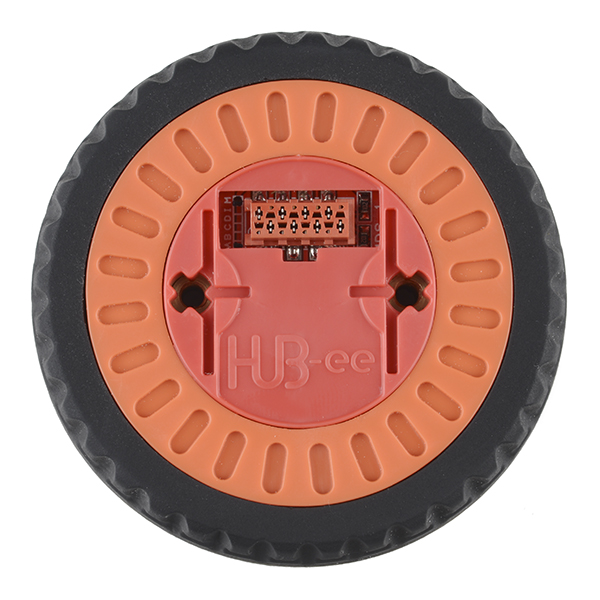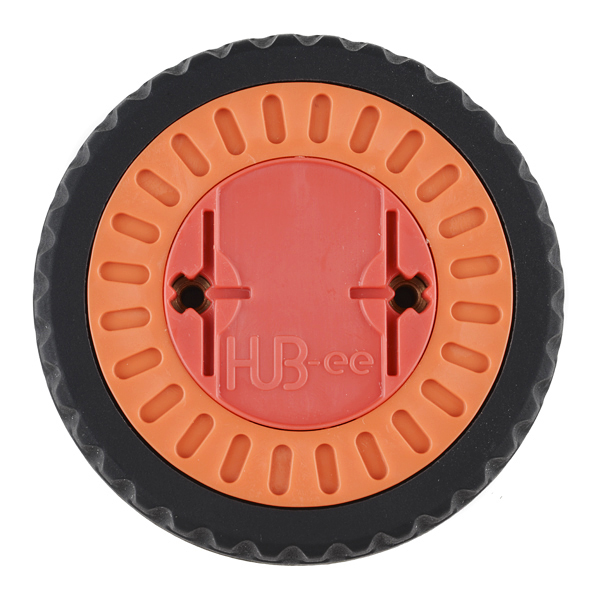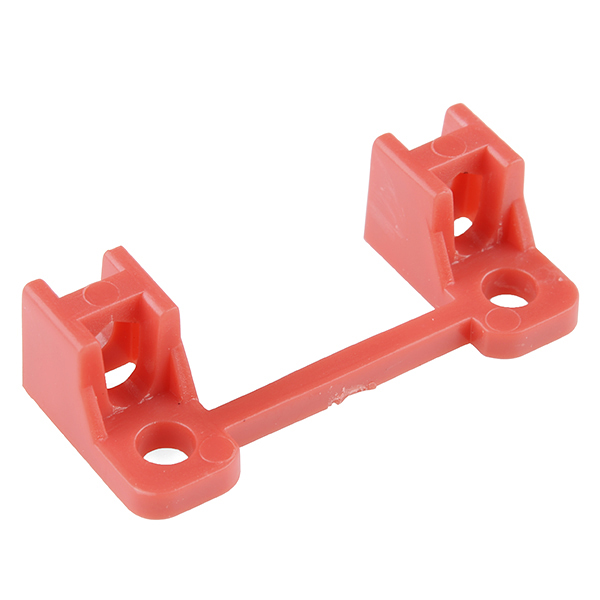HUB-ee Wheel - 120:1 Metric
The HUB-ee is a type of robot servo but designed for wheels, in fact it is a wheel, but it is also a motor, a sensor and a motor controller. What's that? Did we just blow your mind?
When you want to add wheels to your robot you would normally start with a whole collection of parts: The motor and gearbox, a motor driver board, and maybe some sensors for measuring wheel speed and a controller to count revolutions or provide closed loop speed control. Well, the folks over at Creative Robotics thought it would be handy if you could just buy a wheel that had all of those things built in, so they designed HUB-ee - just bolt it onto a chassis, apply power and away you go!
The HUB-ee is easy to mount, too! There are two threaded inserts for M3 bolts built in, there's also a right angle bracket included for situations when you can't go horizontal into the chassis. The mounting holes are even LEGO® lug compatible!! HUB-ee uses Micro-MaTch connectors to keep electrical connections tight and easily changed, check out the related items for mating connectors.
- Removable 12mm Gearmotor
- 120:1 Gear Ratio
- Integrated, Open Source PCB with:
- Motor driver IC
- 32 stripe (128 counts per revolution) quadrature encoder
- Designed for Tires or Tank Tracks (Tires Included)
- Two internal threaded inserts (M3) make it easy to bolt on to a chassis.
- LEGO® Compatible Mounting Sockets
- Operating voltage: 3.5-13.5V
- Logic inputs: 3.3-5V
- Sensor Outputs: 3.3V
- 170RPM @ 7V no load
- 950mA Stall Current
- 100mA No Load
HUB-ee Wheel - 120:1 Metric Product Help and Resources
Core Skill: Robotics
This skill concerns mechanical and robotics knowledge. You may need to know how mechanical parts interact, how motors work, or how to use motor drivers and controllers.
Skill Level: Rookie - You will be required to know some basics about motors, basic motor drivers and how simple robotic motion can be accomplished.
See all skill levels
Core Skill: DIY
Whether it's for assembling a kit, hacking an enclosure, or creating your own parts; the DIY skill is all about knowing how to use tools and the techniques associated with them.
Skill Level: Noob - Basic assembly is required. You may need to provide your own basic tools like a screwdriver, hammer or scissors. Power tools or custom parts are not required. Instructions will be included and easy to follow. Sewing may be required, but only with included patterns.
See all skill levels
Core Skill: Programming
If a board needs code or communicates somehow, you're going to need to know how to program or interface with it. The programming skill is all about communication and code.
Skill Level: Rookie - You will need a better fundamental understand of what code is, and how it works. You will be using beginner-level software and development tools like Arduino. You will be dealing directly with code, but numerous examples and libraries are available. Sensors or shields will communicate with serial or TTL.
See all skill levels
Core Skill: Electrical Prototyping
If it requires power, you need to know how much, what all the pins do, and how to hook it up. You may need to reference datasheets, schematics, and know the ins and outs of electronics.
Skill Level: Noob - You don't need to reference a datasheet, but you will need to know basic power requirements.
See all skill levels
Comments
Looking for answers to technical questions?
We welcome your comments and suggestions below. However, if you are looking for solutions to technical questions please see our Technical Assistance page.
Customer Reviews
No reviews yet.






What is the weight of the wheel?
Is Sparkfun going to carry the electronics board as a spare? I've toasted one (by being a klutz..) and the CreatBots web site doesn't ship across the pond.
dbc - Sorry to hear you toasted your wheel. We will be opening up shipping to the US on CreateBots soon - Unfortunatly that might not help you much as our current shipping solutions to the US (FedEx) would end up costing you more than it would cost to just buy a replacement wheel from Sparkfun. It would only really be worth your while if you wanted to order a bunch of other parts from us as well (and we will be super happy if you decide to do that!)
Anyone know how much play these have in the gears? I need precision motion control and any gear slop plays hell with that.
The short answer is .. quite a bit, probably a couple of degrees - these aren't really designed for ultra precise motion jobs.
I'd like to see how well they would work mounted to the Magician Chassis.
It might just be me but shouldn't the X be vertical so it is a + to be fully lego compatible?
Well, that shouldn't matter much. Most of the time you are putting a Lego axle through a round hole, so it can be in any orientation. Only if you are trying to mate with a beam with a '+' is the orientation going to matter, and that can be worked around. It's more important that the holes fall on 8mm centers. But anyway, I suspect you'd mount them with machines screws anyway.... Lego comes apart to easily under load.
Check out the Mechanical Specs link for an idea of what they mean by 'LEGO® lug compatible'.
The About page has a nice view of the innards as well.
Are there any torque numbers for these wheels? How heavy of a load can they support and push?
I found this on Creative Robotics site. For the 120:1, the stall torque is 1500 g.cm @ 7V (approximately 20 oz/in) For the 180:1, the torque is 2500 g.cm @ 7V (approximately 35 oz/in). Both have a stall current of 950ma @ 7V.